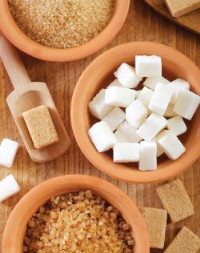Sugar: why do we crave it during winter?
by Nick Rose, PCC Nutrition Educator
This article was originally published in November 2012

When I talk with PCC shoppers about eating seasonally, most think of summer produce as evidence of seasonal eating patterns.
Americans indeed eat more salads and raw foods in the summer, but there is another aspect of dietary seasonality that happens at the end of each year: during the holidays, we all eat more pie, cookies, and other baked goods. They’re full of tradition but also can be full of sugar.
During the cold, dark winter months, we get less sunlight, less exercise, and many people experience Seasonal Affective Disorder (SAD), a mild form of depression. People suffering from SAD start to crave sugary foods to help deal with these winter blahs.
Those with SAD eat more sugar because carbohydrate-rich foods cause blood sugar levels to spike, which raises blood insulin levels. When this happens, the amino acid tryptophan travels up to our brains, where it is converted to serotonin — a hormone that makes us feel happy.
This explains why eating ice cream makes us feel so happy. Ice cream contains plenty of added sugar, plus milk is a natural source of tryptophan. Together, these properties lead to a good release of serotonin to relieve stress and make us feel happy. This form of self-medication makes us feel good in the short-term, but too much sugar will lead to weight gain and other problems.
Miracle sugar?
Almost every year there’s a new “miracle sugar” that our shoppers get excited about, believing that it is healthier somehow than other sugars. Now that the hype over agave has faded, this year’s sugar of the year is coconut palm sugar.
Part of the success of coconut sugar is the recent popularity of all things coconut: more and more shoppers are cooking with coconut oil, drinking coconut water, and snacking on coconut yogurt. It’s not surprising coconut sugar is gaining popularity.
Coconut sugar gets its “miracle sugar” status because it contains traces of potassium, iron, B-vitamins, and it has a (reportedly) low glycemic index (GI). People love the idea of a “healthy sugar” that can be eaten without restrictions.
The hype about coconut sugar, however, is growing faster than the research to support these health claims. I often read claims that coconut sugar has a low GI, and is therefore a great sweetener for diabetics. At this time, however, there is not enough research to support this statement. If it sounds too good to be true, then it probably is. History informs us that hype fades, cavities stay!
A low-GI sweetener is desired because it would not cause blood sugar levels to spike, which is the main health problem associated with consuming too much sugar. The only way for a food high in sugar to have a low GI is if it is high in fiber, which slows absorption of the sugar, or if the sugars are fructose, which does not spike blood sugar levels.
A few years ago, agave was the “miracle sugar” — hyped up because it does not raise blood sugar levels the way other sugars do. Today, we know the reason agave doesn’t raise blood sugar is because of its high fructose content — fructose does not raise blood sugar, but when consumed in excess, it damages the liver and has a negative impact on blood lipids.
Coconut sugar contains no fiber and contains much less fructose than agave, so I question the many low-GI claims made about this new sweetener.
Is there a miracle sugar? Probably not. But there’s also no reason to believe you must eliminate all sweetness from your diet. Common sense informs us that if you are concerned about your sugar intake, you should consume sweets in moderation and add whole grains and nuts to your baked goods for added fiber.
Whatever type of sugar you choose to use this holiday season, by all means use it with love in the kitchen and savor each bite with friends and family. Research shows that when we eat our meals mindfully and with others, we eat better than when we eat alone, or in front of the TV.
